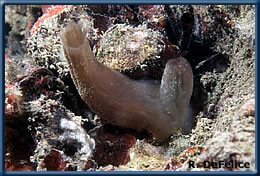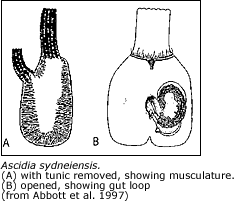

Ascidia sydneiensis

Phallusia nigra

Diademnum sp.
Ascidia sydneiensis
 Gray
sea squirt
Gray
sea squirt
Phylum Chordata
Subphylum Urochordata
Class Ascidiacea
Order Enterogona
Family Ascidiidae
Description
This very common large solitary ascidian has a translucent gray membranous
tunic. It is finely wrinkled with minute hairs and clear enough to let
the brown, orange or reddish body show through. With the tunic removed,
the right side displays a prominent fringe of short, stout muscles fibers
set perpendicular to the margin of the body, with the central region almost
devoid of musculature. A large specimen will have more than 100 oral tentacles.
The S-shaped gut loop is deeply recurved, and the hindgut is typically
grossly swollen and packed with silt (from Abbott et al. 1997).
 Habitat
Habitat
Common in harbors and embayments, it lives in shallow water attached to
any available hard substrate such as dead coral, pier pilings, boat hulls
or floats.
Distribution
Hawaiian Islands
Throughout the main islands and Midway Atoll in harbors and embayments.
Native Range
Most likely Indo-Pacific
Present Distribution
Warm and temperate seas of the Southern Hemisphere
Mechanism of Introduction
Unintentional, as fouling on ships' hulls
Impact
Fouling organism. Ecological impact unstudied, but probably competes with
other shallow-water invertebrates for space, especially in the fouling
community.
Ecology
Feeding
Ascidians are suspension feeders that use a mucous net to filter plankton
from the water. Ciliary action moves water into the oral siphon and to
the pharynx which resembles a basket. As water is pumped through slits
in the pharyngeal basket, out the atrial siphon, it passes through a layer
of mucous coating the inside. When the mucous sheet is clogged with food,
special structures pass it to a short esophagus and into the stomach.
Reproduction
This species is hermaphrodite, with a simple reproductive system. Fertilization
is external, and after a time in the plankton the free-swimming tadpole
larvae will settle and metamorphose.
Remarks
Ascidia sydneiensis is probably the most common large ascidian in calm
waters in Hawaii. It was first recorded in 1940-1941 from Oahu. Abbott
et al. (1997) note that it "exploits docks, floats, boat hulls, solid
debris on mudflats, and other firm substrates in calm habitats such as
Kaneohe Bay, Pearl Harbor, and the Keehi boat harbor."
Although described as "virtually worldwide", "cosmopolitan"
and "widely distributed in the warmer regions of the world"
(Van Name, 1945), Ascidia sydneiensis likely originates in the Australian
- Indo-Pacific region. First described from Port Jackson, Australia, from
material collected intertidally, most of its many synonyms were described
from Indonesia, Sri Lanka, or Australia. It is also known from lagoons
in Tahiti and Moorea, New Caledonia, Palau Island, Japan, and the Indian
Ocean (Seychelles, Isles Maurice, and eastern Africa) (Kott, 1985). It
may be introduced to Japan (where it was first recorded by 1906 [Kott,
1985]).
By 1878 it was recorded from South Africa and by 1881 it was reported
from the Caribbean, at St. Thomas in the West Indies. In the tropical
western Atlantic, it is more restricted in its distribution, being known
from the West Indies and other Caribbean regions, Colombia, and Brazil
(Van Name, 1945), as well as from the "Atlantic coast of Africa",
suggestive of introduction from the Pacific by ship fouling in the 19th
century.
References
Abbott, D.P., A.T. Newberry, and K.M. Morris. 1997. Reef and Shore Fauna
of Hawaii. Section 6B: Ascidians (Urochordata). Bishop Mus. Spec. Pub.
64(6B).
Kott, P. 1985. The Australian Ascidiacea Part 1, Phlebobranchia and Stolidobranchia.
Mem. Queensland Mus. 23: 1-440.
Van Name, W.G. 1945. The North and South American ascidians. Bull. Amer.
Mus. Nat. Hist. 84: 1-476.
© 2002 Hawaii Biological Survey, Bishop Museum
contact